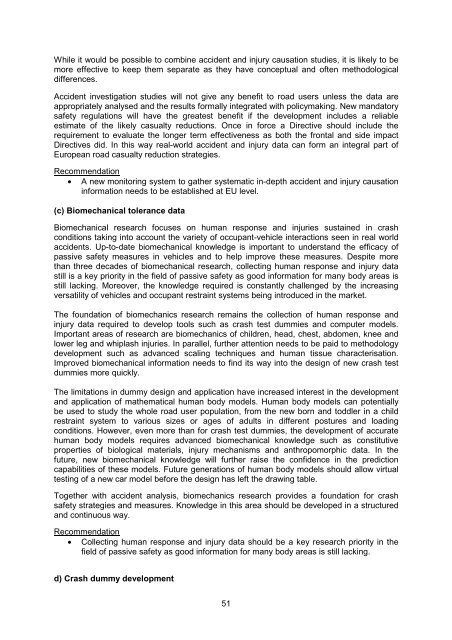PRIORITIES FOR EU MOTOR VEHICLE SAFETY DESIGN
priorities for eu motor vehicle safety design - ETSC
priorities for eu motor vehicle safety design - ETSC
You also want an ePaper? Increase the reach of your titles
YUMPU automatically turns print PDFs into web optimized ePapers that Google loves.
While it would be possible to combine accident and injury causation studies, it is likely to be<br />
more effective to keep them separate as they have conceptual and often methodological<br />
differences.<br />
Accident investigation studies will not give any benefit to road users unless the data are<br />
appropriately analysed and the results formally integrated with policymaking. New mandatory<br />
safety regulations will have the greatest benefit if the development includes a reliable<br />
estimate of the likely casualty reductions. Once in force a Directive should include the<br />
requirement to evaluate the longer term effectiveness as both the frontal and side impact<br />
Directives did. In this way real-world accident and injury data can form an integral part of<br />
European road casualty reduction strategies.<br />
Recommendation<br />
• A new monitoring system to gather systematic in-depth accident and injury causation<br />
information needs to be established at <strong>EU</strong> level.<br />
(c) Biomechanical tolerance data<br />
Biomechanical research focuses on human response and injuries sustained in crash<br />
conditions taking into account the variety of occupant-vehicle interactions seen in real world<br />
accidents. Up-to-date biomechanical knowledge is important to understand the efficacy of<br />
passive safety measures in vehicles and to help improve these measures. Despite more<br />
than three decades of biomechanical research, collecting human response and injury data<br />
still is a key priority in the field of passive safety as good information for many body areas is<br />
still lacking. Moreover, the knowledge required is constantly challenged by the increasing<br />
versatility of vehicles and occupant restraint systems being introduced in the market.<br />
The foundation of biomechanics research remains the collection of human response and<br />
injury data required to develop tools such as crash test dummies and computer models.<br />
Important areas of research are biomechanics of children, head, chest, abdomen, knee and<br />
lower leg and whiplash injuries. In parallel, further attention needs to be paid to methodology<br />
development such as advanced scaling techniques and human tissue characterisation.<br />
Improved biomechanical information needs to find its way into the design of new crash test<br />
dummies more quickly.<br />
The limitations in dummy design and application have increased interest in the development<br />
and application of mathematical human body models. Human body models can potentially<br />
be used to study the whole road user population, from the new born and toddler in a child<br />
restraint system to various sizes or ages of adults in different postures and loading<br />
conditions. However, even more than for crash test dummies, the development of accurate<br />
human body models requires advanced biomechanical knowledge such as constitutive<br />
properties of biological materials, injury mechanisms and anthropomorphic data. In the<br />
future, new biomechanical knowledge will further raise the confidence in the prediction<br />
capabilities of these models. Future generations of human body models should allow virtual<br />
testing of a new car model before the design has left the drawing table.<br />
Together with accident analysis, biomechanics research provides a foundation for crash<br />
safety strategies and measures. Knowledge in this area should be developed in a structured<br />
and continuous way.<br />
Recommendation<br />
• Collecting human response and injury data should be a key research priority in the<br />
field of passive safety as good information for many body areas is still lacking.<br />
d) Crash dummy development<br />
51



